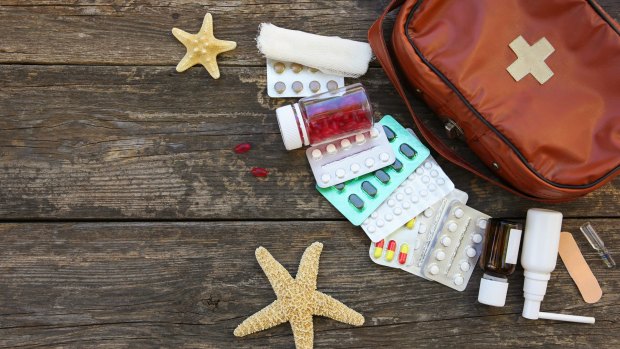This was published 4 years ago
The 10 things you should pack for third-world countries
By Sheriden Rhodes

If you're headed to a less developed country there are a few extra things you need to pack.Credit: iStock
In the excitement of travelling to a developing country – where rules and regulations are more relaxed, you can bargain for souvenirs and it's spectacularly inexpensive to eat out – it's easy to overlook the downside. Like what happens if you fall ill and are a long, long way from a pharmacy or doctor? Or you're trekking somewhere remote and your boots fall apart? It happens. Trust me.
For the most part, a solution can be found. But why risk it? Here are some essentials to pack for a trip to a developing nation.
Anti-diarrhoea medication and pain killers
Sometimes you get sick even when taking all the necessary precautions. Take the time I chose to eat at a "safe" looking café rather than an "unhealthy" McDonalds while transiting through Ho Chi Minh City airport. Boy, did I regret spurning a cheeseburger 12 hours later while gripped by stomach cramps and everything food poisoning throws at you (I'll spare you the details).
While we were staying at a five-star resort in Quy Nhon, there was no chemist nearby and no easy means to reach one. Thankfully my mum had earlier slipped some Imodium into my handbag. Now I carry it wherever I go. Electrolytes, travel sickness tablets and pain killers are great to have on hand, too.
Hand sanitiser and anti-bacterial wipes
Naomi Campbell has the most extreme travel sanitation routine I've seen, yet she makes a valid point. Planes, public toilets, ATM's all harbour germs. In developing nations sometimes there's nowhere available to wash your hands before eating; other times the only option looks scarily unhygienic.
The easiest solution is hand sanitiser. Just be sure to buy one that's at least 60 per cent alcohol and 100 millilitres or under if carrying it in your hand luggage on international flights. And follow Campbell's lead: wipe that tray table, TV remote, dining surface!
Cable ties and gaffer tape
Anyone that saw the movie Wild knows that Cheryl Strayed (played by Reese Witherspoon) could not have completed the Pacific Crest Trail without gaffer tape. Michele Eckersley, from World Expeditions, says boots often fall apart on the first day of a trek in a remote place and, annoyingly, you can be days away from help. She said this is typically because the glue on boots has been damaged previously – perhaps by putting wet boots near a fire. Gaffer tape, she says, when applied correctly can help keep boots together (the tape needs to go between the heel and the ball of the foot so it doesn't wear out within a couple of kilometres).
Similarly cable ties can solve a multitude of problems. After losing the clip on her pack's waist strap, leaving her with the horrendous possibility of having to carry a full pack for six days with all the weight on her shoulders, Eckersley's guide fashioned a new clip made from two cable ties. This meant she could walk with the pack weight distributed comfortably.
See also: US airport security trashed my bag and then taped it back together
Insect repellent
Obviously it's a good idea when travelling to a country with known diseases to get vaccinated or take preventative medicine before hopping on the plane (ask your GP beforehand). You can protect yourself further from malaria and dengue fever by also packing insect repellent and long-sleeved tops and long-legged pants says Tara Kennaway, regional product manager with Intrepid Travel.
Mosquito nets (usually available at accommodation providers in the tropics) are also an excellent precaution. Just remember to protect kids, too. When travelling with our daughter to Bali as a baby (packing for a baby is a whole other post), she woke from her portable cot ravaged by mosquitos while my husband and I, protected by a net, were bite free. I still feel guilty about it.
Portable or solar-powered charger
When travelling through remote areas you may be hard pressed to find charging ports for your devices while some countries (India, Nepal) are prone to power outages. Bring a portable charger and charge it while you sleep or whenever you have a chance. Even better, bring a solar charger.
Prescription medicine
While most developing nations have pharmacies, and many offer over-the-counter drugs you can't easily get at home, you should pack enough prescription medicine to last the duration of your trip.
Be sure and pack it in your carry-on luggage (in case your bag gets lost) along with the prescription itself. An anti-itch cream and antihistamines are also useful to have in your medical kit. Although many swear by Lucas' Pawpaw ointment for everything from cuts, bites, nappy rash, sunburn and chapped skin.
Feminine products
Tampons, and sometimes pads, can be hard to find in developing countries – surprisingly even in Bali visited by millions of western tourists each year. Or they're crazy expensive ($25 for a pack of tampons in the Maldives). In some rural and remote areas they're simply unavailable, while tampons in some countries, such as China and Cambodia, are taboo. Pack what you need and you won't be caught out.
Sign up for the Traveller newsletter
The latest travel news, tips and inspiration delivered to your inbox. Sign up now.